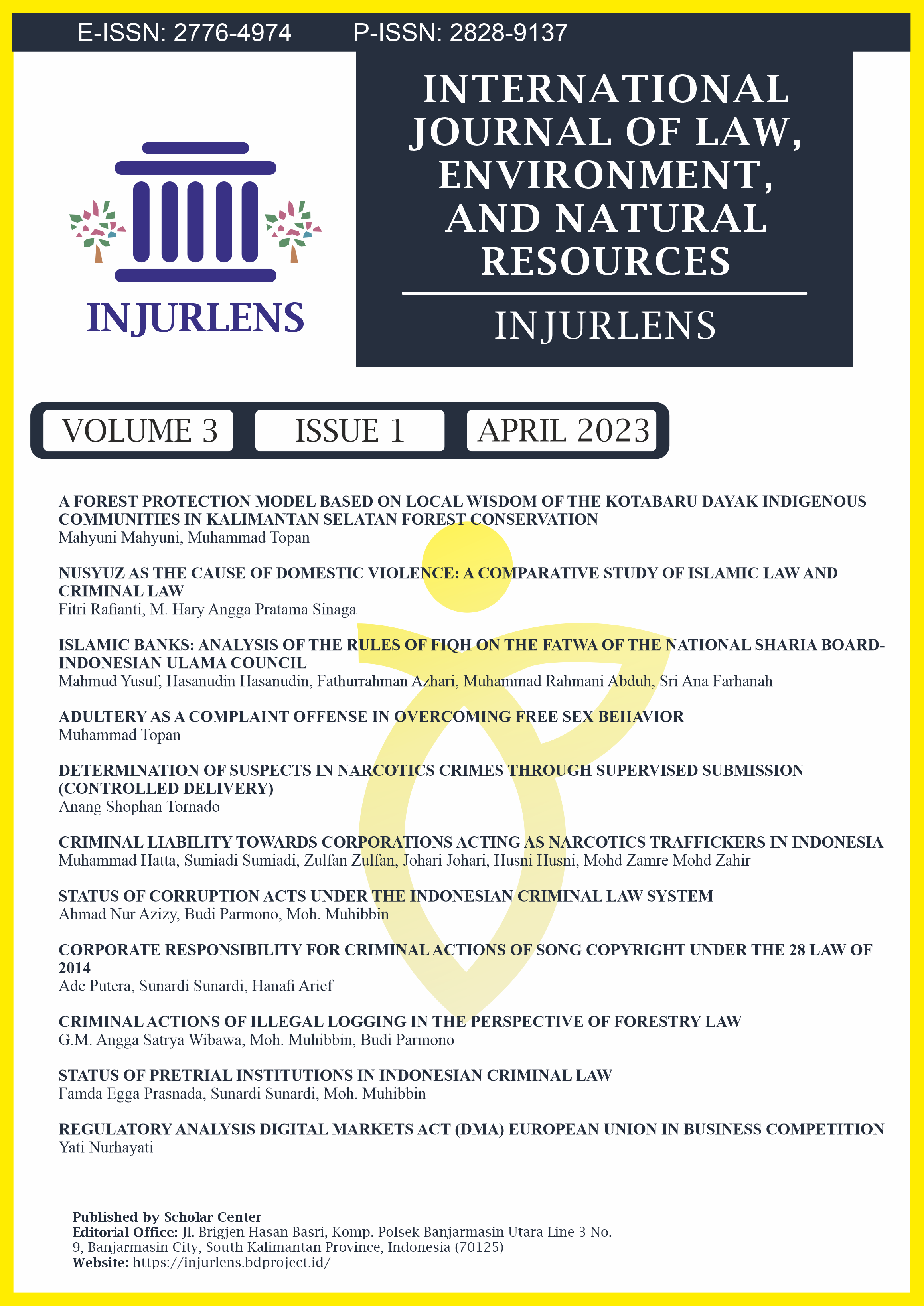A Forest Protection Model Based on Local Wisdom of the Kotabaru Dayak Indigenous Communities in Kalimantan Selatan Forest Conservation
DOI:
https://doi.org/10.51749/injurlens.v3i1.36Keywords:
Forest, Local Wisdom, Customary Law, Dayak Tribe, Kalimantan SelatanAbstract
Indonesia's forest management is still unable to fulfill the constitutional mandate, thus driving the rate of forest degradation and deforestation. This very high damage occurred in the concession area, therefore forest management in customary lands must be returned to indigenous peoples who do have constitutional rights. Furthermore, based on previous research conducted by the World Resource Institute, forest management under the control of indigenous peoples runs more effectively than forest management outside the scope of adat and can reduce the rate of forest deforestation. The purpose of this research is to answer 2 (two) main issues, namely; (1) Analyzing forest protection based on local laws of the Dayak Kotabaru indigenous people on environmental sustainability; (2) Finding a forest protection model based on the local law of the Dayak Kotabaru indigenous people in Kalimantan Selatan. The research method used in the first year is an empirical research method that examines the forest protection model based on local laws of the indigenous Dayak community in Kalimantan Selatan. In the second year, using the socio-legal research, discovered the concept of regional policies in forest management based on the values ??contained in the local legal system of the Dayak indigenous people in Kalimantan Selatan.
Downloads
References
Books
Fetterman, D. M. (1998). Ethnography Step by Step. Sage Publishing.
Muhammad, Jayadi Edi. (2020). Pengelolaan Hutan Adat Berbasis Kearifan Lokal. Mataram: Sanabil
Salim, H. S. (2005). Dasar-Dasar Hukum Kehutanan. Sinar Grafika.
Travers, R. B. and M. (2005). Socio-Legal Research Methods (Structured Interviewing) (2nd Editio). OUP.
Journals
Abby dan Barkatullah, (2015), “Analisis Yuridis Terhadap Hak Adat Atas Tanah Di Masyarakat Adat Kalimatan Selatan Ditinjau Dari Undang-Undang Nomor 5 Tahun 1960 Tentang Pokok-Pokok Agraria” DPD RI Collaborative Research with the Law Faculty of Lambung Mangkurat University, Banjarmasin.
Bambang Wiyono, (2018), “Kedudukan Hutan Adat Pasca Putusan Mahkamah Konstitusi Nomor 35/PUU-IX/2012 dan Hubungannya Dengan Pengelolaan Hutan di Indonesia” Journal Aktualita, Vol.1 No.1 June
Bernard Steny, Pluralisme Hukum: Antara PERDA Pengakuan Masyarakat Adat dan Otonomi Hukum Lokal”, Jurnal Pembaharuan Desa dan Agraria, Vol III No. III, 2006, IPB
Dian Cahyaningrum, (2015), “Implikasi Putusan Mahkamah Konstitusi Mengenai Status Hutan Adat Sebagai Hutan Hak”, Journal Kajian Vol. 20 No. 1 Maret
Hadi, I. (2011). Penegakan Hukum Lingkungan Berdasarkan Kearifan Masyarakat Adat Dalam Upaya Pelestarian Fungsi Lingkungan Hidup. Universitas Padjajaran.
Imamul Hadi, (2011) “Penegakan Hukum Lingkungan Berdasarkan Kearifan Masyarakat Adat Dalam Upaya Pelestarian Fungsi Lingkungan Hidup”, Disertasi, Universitas Padjajaran
J. Sahalessy, (2011) “Peran Latupati Sebagai Lembaga Hukum Adat Dalam Penyelesaian Konflik Antar Negeri Di Kecamatan Leihitu Propinsi Maluku”, Journal Sasi, Vol. 17 No. 3 July-September.
Oman Sukmana, (2016, ”Konsep dan Desain Negara Kesejahteraan (Welfare State)”, Jurnal Sosial Politik, Vol.2 No.1 July-Desember.
Rosmidah, (2010) “Pengakuan Hukum Terhadap Hak Ulayat Masyarakat Hukum Adat Dan Hambatan Implementasinya”, Inovatif, Jurnal Ilmu Hukum Vol. 2 No. 2.
Steny, B. (2006). Pluralisme Hukum: Antara PERDA Pengakuan Masyarakat Adat dan Otonomi Hukum Lokal. Jurnal Pembaharuan Desa Dan Agraria, III(III).
Website
Arief Wijaya dkk. “Satu Dekade Deforestasi di Indonesia, di Dalam dan di Luar Area Konsesi” in acces melalui https://wri-indonesia.org pada 27 Mei 2018.
Interview
Dayak, H. of B. (n.d.). Field interview with the Head of Bangkalaan Dayak Customs.
Downloads
Published
How to Cite
Issue
Section
License
Copyright (c) 2023 Mahyuni Mahyuni, Muhammad Topan

This work is licensed under a Creative Commons Attribution-NonCommercial-ShareAlike 4.0 International License.
Injurlens is licensed under a Creative Commons Attribution-NonCommercial-ShareAlike 4.0 International License
Articles in Injurlens are Open Access articles published under the Creative Commons CC BY-NC-SA License This license permits use, distribution and reproduction in any medium for non-commercial purposes only, provided the original work and source is properly cited. Any derivative of the original must be distributed under the same license as the original.

